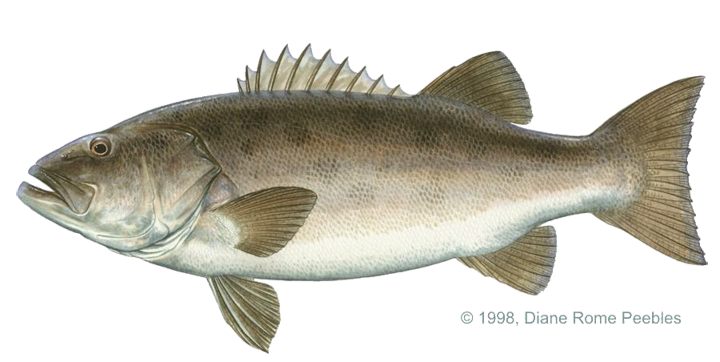Game Fish Identification Reference Guides
Bass, giant sea
(Stereolepis gigas)
(Stereolepis gigas)

Ayres, 1859; POLYPRIONIDAE FAMILY; also called California black sea bass, California jewfish
Occurs in tropical and subtropical inshore waters of the northeast Pacific off the California and Mexican coasts. Also known on the Asiatic Pacific coast. Despite its great size, the giant sea bass is an inhabitant of near shore waters, particularly over hard, rocky bottoms and around kelp beds. The young can be found in depths of about 6 to 15 fathoms. Larger specimens can generally be found in depths of 15 to 25 fathoms. Diet includes crustaceans and a wide variety of fishes.
The first dorsal fin is very low and consists of 11 spines. The second dorsal fin is higher than the first, and consists of 10 soft rays. The presence of more dorsal spines than soft rays distinguishes the giant sea bass from any similar related species, including the jewfish, Epinephelus itajara. All the fins are black (though the ventral fins appear lighter because the white membrane shows clearly between the black spines). Juveniles are brick red with conspicuous dark spots and a few pale yellow blotches on the body; the fins are black or transparent.
Fishing methods are live or dead bait fishing from an anchored or drifting boat with large natural baits. Fishing is best in the 10 to 25 fathom range.
The giant sea bass and its close relative the jewfish are the giants of the bass family
Occurs in tropical and subtropical inshore waters of the northeast Pacific off the California and Mexican coasts. Also known on the Asiatic Pacific coast. Despite its great size, the giant sea bass is an inhabitant of near shore waters, particularly over hard, rocky bottoms and around kelp beds. The young can be found in depths of about 6 to 15 fathoms. Larger specimens can generally be found in depths of 15 to 25 fathoms. Diet includes crustaceans and a wide variety of fishes.
The first dorsal fin is very low and consists of 11 spines. The second dorsal fin is higher than the first, and consists of 10 soft rays. The presence of more dorsal spines than soft rays distinguishes the giant sea bass from any similar related species, including the jewfish, Epinephelus itajara. All the fins are black (though the ventral fins appear lighter because the white membrane shows clearly between the black spines). Juveniles are brick red with conspicuous dark spots and a few pale yellow blotches on the body; the fins are black or transparent.
Fishing methods are live or dead bait fishing from an anchored or drifting boat with large natural baits. Fishing is best in the 10 to 25 fathom range.
The giant sea bass and its close relative the jewfish are the giants of the bass family












